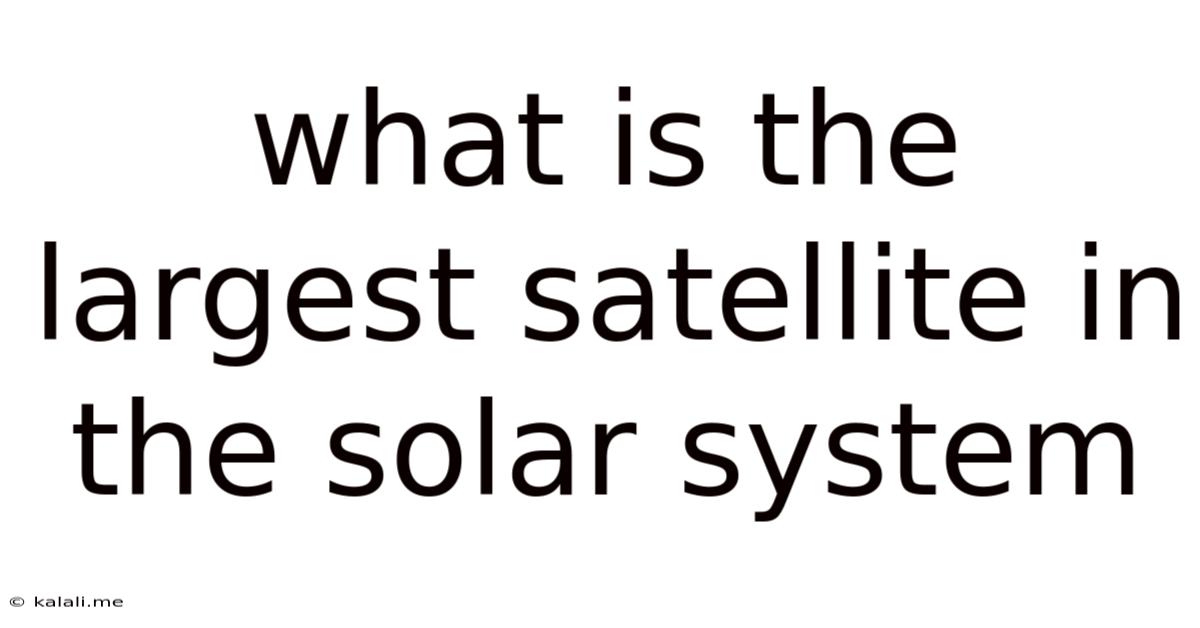What Is The Largest Satellite In The Solar System
Kalali
Jun 11, 2025 · 3 min read

Table of Contents
What is the Largest Satellite in the Solar System? Unlocking the Secrets of Ganymede
The solar system is a vast and wondrous place, teeming with planets, moons, asteroids, and comets. Among this celestial collection, the question of the largest satellite often arises. While many moons are impressive in their own right, one reigns supreme: Ganymede, a captivating Jovian moon. This article will delve into the fascinating world of Ganymede, exploring its size, composition, and unique characteristics that make it the undisputed champion among solar system satellites.
Ganymede, a moon of Jupiter, is the largest moon in our solar system, significantly eclipsing even the planet Mercury in size. Its immense diameter of approximately 3,273 miles (5,268 kilometers) makes it a truly colossal celestial body. This impressive size immediately sets it apart from other moons, including Saturn's Titan and Jupiter's Callisto and Io.
Ganymede's Unique Characteristics: More Than Just Size
Ganymede's significance goes beyond its sheer size. It possesses a fascinating and complex composition, including:
- A differentiated interior: Similar to terrestrial planets, Ganymede has a metallic core, a rocky mantle, and a surface layer of ice. This internal structure suggests a history of geological activity, including possible volcanic eruptions in its past.
- A tenuous atmosphere: The moon boasts a thin atmosphere primarily composed of oxygen, a byproduct of the interaction of charged particles from Jupiter's magnetosphere with the surface ice.
- A magnetic field: Remarkably, Ganymede is the only moon known to possess its own intrinsic magnetic field, a feature not shared by any other satellite in the solar system. This magnetic field is thought to be generated by the movement of conductive fluids within its metallic core, further supporting the hypothesis of a differentiated internal structure. This magnetic field even interacts with Jupiter's larger magnetosphere, creating a complex and dynamic interplay.
- Varied Surface Features: Ganymede's surface is a breathtaking tapestry of ancient, heavily cratered terrains and younger regions characterized by grooves and ridges. These tectonic features hint at past geological processes and internal evolution. The contrast between these regions offers valuable insights into the moon’s dynamic history.
Comparing Ganymede to Other Large Moons
While Titan is often mentioned in the same breath as Ganymede due to its impressive size, Ganymede significantly surpasses it in diameter. Although Titan boasts a dense atmosphere, making it a unique and fascinating world in its own right, it still falls short of Ganymede's overall dimensions. Similarly, Callisto and Io, other prominent Jovian moons, are considerably smaller.
The Significance of Ganymede's Discovery and Ongoing Research
The discovery of Ganymede by Galileo Galilei in 1610 marked a turning point in our understanding of the solar system, significantly expanding the known inventory of celestial bodies. Ongoing research using sophisticated telescopes and space probes continues to reveal new details about this fascinating moon, pushing the boundaries of our knowledge about the formation and evolution of planetary systems.
In conclusion, Ganymede's remarkable size, complex internal structure, unique magnetic field, and diverse surface features establish it as the largest and one of the most intriguing satellites in our solar system. Ongoing exploration and research promise further revelations about this captivating celestial body, enriching our understanding of the universe's boundless wonders.
Latest Posts
Latest Posts
-
Least Common Denominator Of 9 And 7
Jul 01, 2025
-
How Many Feet In A Mile And A Half
Jul 01, 2025
-
11am To 9pm Is How Many Hours
Jul 01, 2025
-
How Many Feet Are In 50 Yards
Jul 01, 2025
-
How Many Cups Are In 3 Quarts
Jul 01, 2025
Related Post
Thank you for visiting our website which covers about What Is The Largest Satellite In The Solar System . We hope the information provided has been useful to you. Feel free to contact us if you have any questions or need further assistance. See you next time and don't miss to bookmark.